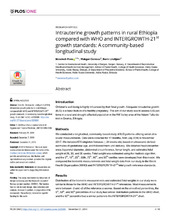| dc.description.abstract | Introduction Children’s well-being is highly influenced by their fetal growth. Adequate intrauterine growth (IUG) is a basic feature of a healthy pregnancy. The aim of our study was to assess IUG patterns in a rural and drought-affected population in the Rift Valley area of the Adami Tullu district in Oromia, Ethiopia. Methods We conducted a longitudinal, community-based study of IUG patterns utilizing serial ultrasound measurements. Data were collected for 17 months, from July 2016 to November 2017. We included 675 singleton foetuses ≤ 24 weeks old, based on ultrasound-derived estimates of gestational age, and followed them until delivery. We obtained head circumference, biparietal diameter, abdominal circumference, femur length, and estimated fetal weight at 26, 30, and 36 weeks. Fetal weight was estimated using the Hadlock algorithm, and the 5th, 10th, 25th, 50th, 75th, 90th, and 95th centiles were developed from this model. We compared the biometric measurements and fetal weight data from our study to the World Health Organization (WHO) and INTERGROWTH-21st fetal growth reference standards. Results Distribution of the biometric measurements and estimated fetal weights in our study were similar to those for the WHO and INTERGROWTH-21st references. Most measurements were between -2 and +2 of the reference z-scores. Based on the smoothed percentiles, the 5th, 50th, and 95th percentiles of our study had similar distribution patterns to the WHO chart, and the 50th percentile had a similar pattern to the INTERGROWTH-21st chart. Conclusions Our study determined fetal growth patterns in a drought-affected rural community of Ethiopia using common ultrasound biometric measurements. We found similar IUG patterns to those indicated in the WHO and INTERGROWTH-21st fetal growth reference standards. | en_US |

